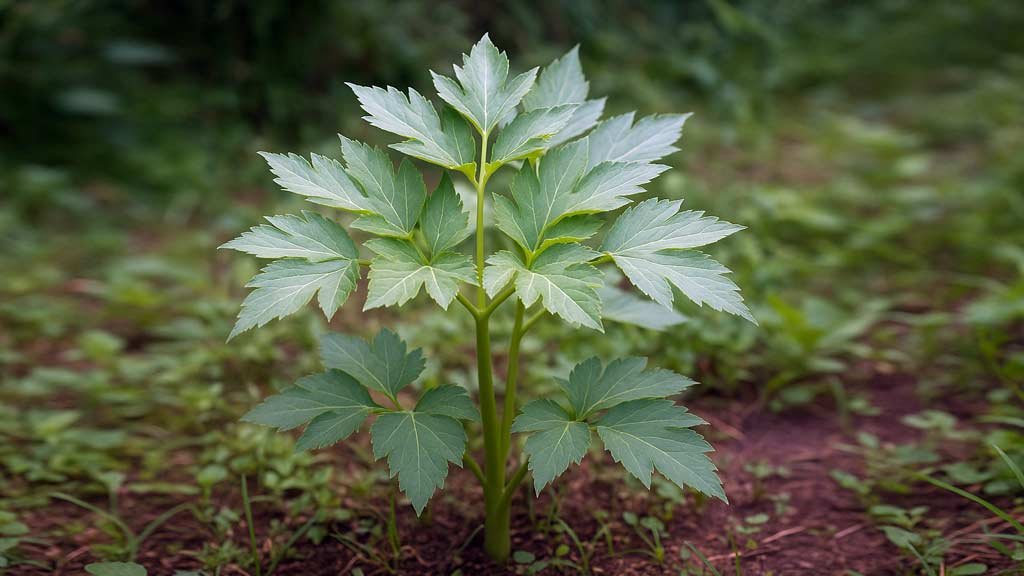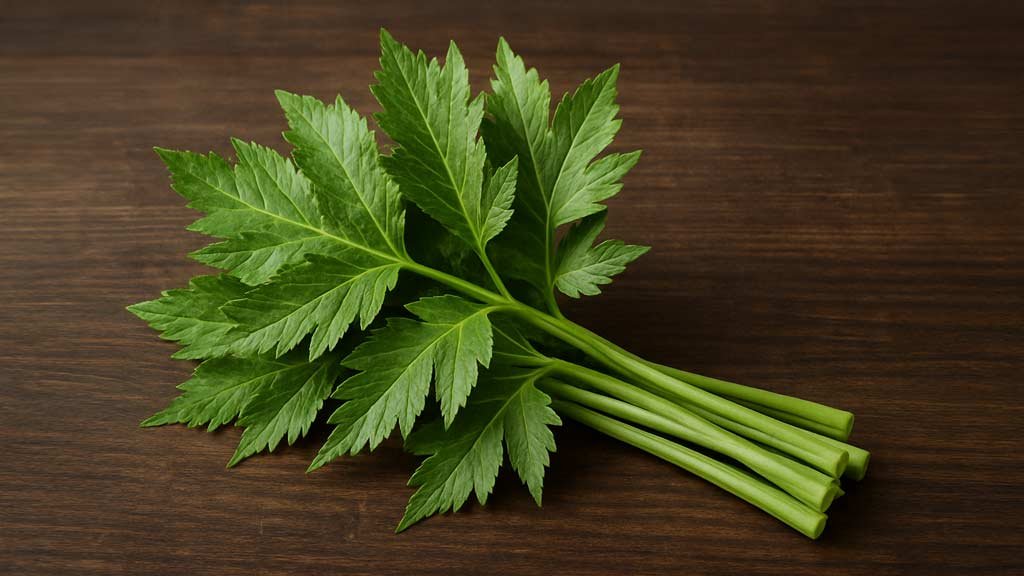A Green Wonder from Japan
Ashitaba herb (Angelica keiskei) has a reputation that precedes it—often called the “tomorrow’s leaf” in Japan, a nod to its remarkable growth. Cut a leaf today, and by tomorrow, it sprouts anew. That resilience isn’t just poetic; it mirrors the plant’s medicinal promise. People have long turned to Ashitaba to maintain vitality, support energy, and promote longevity.
Its bright green leaves carry a fresh, slightly bitter flavor—earthy, almost like a subtle cross between celery and mild kale. Crush one between your fingers and there’s an unmistakable herbal brightness, a hint of peppery warmth. You can imagine centuries of islanders sipping it in teas or cooking it lightly to retain its essence.
Table of Contents
The Science Behind the Vitality
What makes Ashitaba herb so fascinating isn’t just tradition—it’s the compounds it harbors. Chalcones, flavonoids, and polyphenols predominate, conferring antioxidant, anti-inflammatory, and potential adaptogenic properties. These phytochemicals help combat oxidative stress, support cellular renewal, and may enhance stamina and energy.
Some studies suggest:
- Chalcones: Promote cell repair and longevity, with antioxidant and anti-inflammatory activity
- Flavonoids: Support cardiovascular health and improve circulation
- Polysaccharides: Strengthen immunity and aid digestion
It’s not a magic bullet, but the combination seems to work quietly over time, offering a gentle nudge toward overall balance.
Longevity in a Leaf
In Japan, Ashitaba herb has been part of the diet for centuries, especially on the Izu and Hachijo islands. Locals credit it with long, healthy lives and consistent energy well into old age. Traditional consumption ranges from fresh leaves in salads to teas, juices, or light stir-frying.
It’s remarkable to think about—how a small, green leaf can quietly reinforce health daily. There’s almost a ritualistic quality in preparing it: tearing the leaf, inhaling its fresh scent, simmering it briefly in water. The act itself feels renewing.
Ways Locals Use Ashitaba
- Steamed or lightly sautéed leaves for daily meals
- Fresh leaf juice, sometimes mixed with other greens
- Infused teas for energy and digestion
- Powdered supplements for convenient daily dosing
Even casual use seems to impart benefits over time—a gentle, cumulative effect rather than a dramatic, immediate change.
Ashitaba Herb and Energy Support
One of the most cited effects is an increase in energy and stamina. Many report feeling lighter, more alert, and less fatigued after incorporating Ashitaba into their routines. The bioactive compounds support healthy mitochondrial function and oxidative stress management, which may explain why people notice more sustained energy.
Anecdotally, early morning teas brewed with fresh leaves or powdered Ashitaba have a slightly sweet, earthy aftertaste. It’s grounding—reminds you that real energy often comes from nurturing the body steadily rather than forcing it with caffeine or sugar spikes.
Cellular Renewal and Antioxidant Power
Ashitaba herb’s antioxidants do more than boost energy—they help defend cells from free radical damage. This is crucial for aging gracefully, maintaining skin elasticity, and supporting organ health. Regular consumption, even in modest amounts, is said to contribute to:
- Reduced cellular stress
- Enhanced repair mechanisms
- Support for liver and kidney function
- Maintenance of skin vitality
You can almost imagine these compounds patrolling cells like tiny gardeners, clearing debris and nourishing the soil, letting the plant’s energy become yours.
Digestion and Gut Health
Ashitaba isn’t just for energy—it also supports digestion. Traditional Japanese herbalists often recommended it for bloating, sluggish bowels, or occasional discomfort. Its fiber content, combined with bioactive compounds, promotes smooth gastrointestinal function.
Even just a few fresh leaves in a stir-fry or a cup of tea can help the system move along gently. It’s one of those herbs that doesn’t demand attention—works quietly in the background, a subtle partner to your digestive health.
Adaptogenic Qualities
While Ashitaba isn’t a classical adaptogen, many reports suggest it helps the body respond better to stress. Regular consumption may help stabilize mood, support endurance, and reduce the feeling of mental fatigue.
Some practical effects people notice:
- Slightly improved focus and mental clarity
- Reduced post-workout fatigue
- A sense of lightness or grounded energy throughout the day
The effects aren’t dramatic, but they are persistent. That’s the beauty of Ashitaba herb—it’s reliable over months, not flashy for a single day.
How to Prepare and Use Ashitaba Herb
Fresh leaves are preferred, but powdered or dried forms are convenient and widely available. Here are practical ways to incorporate it:
- Fresh leaves: Chop and stir-fry lightly or add to salads
- Teas: Steep 1–2 teaspoons of fresh or dried leaves in hot water for 10–15 minutes
- Juice: Blend with other leafy greens for a morning boost
- Powdered supplements: Convenient for mixing into smoothies or shakes
Cooking lightly preserves the plant’s bright green color and delicate nutrients. Overcooking can dull flavor and reduce potency. Taste is earthy, slightly bitter, with a mild sweetness that emerges when chewed slowly.
Safety Considerations
Ashitaba herb is generally considered safe for daily use, but some points to keep in mind:
- Start with small amounts if you’re new to the herb
- Rarely, some people may experience mild digestive upset
- Pregnant or breastfeeding women should consult a healthcare professional before regular use
- High doses of powdered extracts should be approached cautiously
Moderation is key. This is a plant to integrate gently, over time.

Anecdotes and Lifestyle Integration
I remember trying Ashitaba tea during a chilly morning on a Japanese island. The steam rose, carrying the green, earthy aroma, and there was a subtle warmth, as if the herb was coaxing energy into my limbs. That day, I felt lighter, more alert—small, quiet effects that compounded over the week.
Many people incorporate it similarly: a leaf in breakfast, a small tea after lunch, perhaps a powdered smoothie in the evening. It becomes a rhythm, a daily acknowledgment that the body deserves a little renewal.
Beyond Energy: Overall Benefits
Ashitaba herb’s influence extends further:
- Longevity support: Traditional wisdom links it with extended healthspan
- Heart health: Flavonoids may support circulation and cardiovascular function
- Immune modulation: Polysaccharides and antioxidants aid resilience
- Detox support: Promotes liver health and cellular cleansing
It’s a holistic approach, blending energy, resilience, and subtle restoration into daily life.
Growing Your Own Ashitaba Herb
If you have a bright windowsill or a garden with partial shade, Ashitaba grows readily. It prefers well-drained soil and moderate water. Harvest leaves as needed—they regenerate quickly, true to the “tomorrow’s leaf” nickname. Growing your own lets you enjoy fresh, potent leaves whenever you like, and something is grounding in tending a plant that mirrors the vitality you seek.
Integrating Ashitaba into Daily Rituals
The true magic isn’t in occasional consumption—it’s in ritual. Morning tea, a handful of fresh leaves in a smoothie, or a lightly sautéed side dish can reinforce the herb’s benefits over time. That slow, steady integration seems to amplify its effects on energy, renewal, and wellbeing.
The beauty of Ashitaba herb is that it’s not flashy. It doesn’t promise miracles. Instead, it quietly reminds you to respect your body, nourish it daily, and savor the process of living well.
Article Sources
At AncientHerbsWisdom, our content relies on reputable sources, including peer-reviewed studies, to substantiate the information presented in our articles. Our primary objective is to ensure our content is thoroughly fact-checked, maintaining a commitment to accuracy, reliability, and trustworthiness.
- Caesar, L. K., & Cech, N. B. (2016). A review of the medicinal uses and pharmacology of Ashitaba (Angelica keiskei). Planta Medica, 82(14), 1236–1245. https://doi.org/10.1055/s-0042-110496
- Medical News Today. (2019, February 21). This Japanese plant could hold the key to extended youth. https://www.medicalnewstoday.com/articles/324508
- WebMD. (n.d.). Ashitaba – Uses, side effects, and more. https://www.webmd.com/vitamins/ai/ingredientmono-1134/ashitaba
- Kweon, M., Lee, S., & Kim, H. (2019). A chalcone from Ashitaba (Angelica keiskei) stimulates myogenesis and prevents muscle atrophy. Molecules, 24(24), 4421. https://doi.org/10.3390/molecules24244421
- Rowhanirad, S., & Lee, H. (2023). The neuroprotective effects of chalcones from Ashitaba on cuprizone-induced demyelination via modulation of brain-derived neurotrophic factor and tumor necrosis factor α. Brain Research Bulletin, 179, 13–22. https://doi.org/10.1016/j.brainresbull.2023.03.004
- Ohkura, N., & Kato, M. (2019). Ashitaba (Angelica keiskei) exerts possible beneficial effects on metabolic syndrome. International Journal of Clinical Medicine, 10(1), 5–12. https://doi.org/10.4236/ijcm.2019.101002
- Kalman, D. S., & Hackel, V. (2018). A study to evaluate ChalCurb®, a standardized powder derived from the sap of Angelica keiskei (Ashitaba), on markers of health in adults with metabolic syndrome. Advances in Obesity, Weight Management & Control, 8(3), 1–10. https://doi.org/10.15406/aowmc.2018.08.00261
- Wahyuni, I., & Suryadi, A. (2024). The pharmacology activities of Angelica keiskei Koidzumi: A review. Pharmacognosy Communications, 14(2), 1–9. https://doi.org/10.5530/pc.2024.2.1
- Odongo, K., & Hara, Y. (2025). Ashitaba chalcone 4-hydroxyderricin promotes glucagon-like peptide-1 secretion and improves hyperglycemia. Molecular Nutrition & Food Research, 69(1), 1–9. https://doi.org/10.1002/mnfr.202400690

